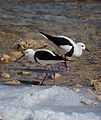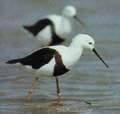Banded stilt
| Banded stilt | |
|---|---|
 | |
| Banded stilts, Governors Lake, Rottnest Island | |
| Conservation status | |
| Scientific classification | |
| Kingdom: | Animalia |
| Phylum: | Chordata |
| Class: | Aves |
| Order: | Charadriiformes |
| Family: | Recurvirostridae |
| Genus: | Cladorhynchus G.R. Gray, 1840 |
| Species: | C. leucocephalus |
| Binomial name | |
| Cladorhynchus leucocephalus (Vieillot, 1816) | |
The banded stilt (Cladorhynchus leucocephalus) is a nomadic stilt endemic to Australia. It belongs to the monotypical genus Cladorhynchus. It gets its name from the red-brown breast band found on breeding adults, but this is mottled or entirely absent in non-breeding adults and juveniles. Its remaining plumage is pied and the eyes are dark brown. They breed whenever the water conditions are suitable for brine shrimp to flourish and lay 3–4 white, brown or black eggs on a scrape. The majority of observed breeding events have occurred at inland salt lakes in South Australia and Western Australia immediately following freshwater inflows. An exception to this exists where some breeding was attempted at The Coorong during a time in which salinity in the Lower Lakes was significantly elevated due to reduced environmental flows down the Murray River.[2]
The species is listed as Vulnerable under the South Australian Parks & Wildlife Act 1972.[3] The listing was made after breeding attempts observed at Lake Eyre revealed heavy predation from silver gulls. DEWNR has developed a strategy for managing silver gull predation at chosen banded stilt breeding sites by applying site-specific culling measures. Breeding events observed at ephemeral lakes in Western Australia have proven to be more successful without the need for intervention due to their remoteness.[2]
For the first time ecologists have tracked the movements of the highly nomadic banded stilt, a large desert bird that travels vast distances across the country to breed in desert salt lakes.
Deakin University researcher Reece Pedler said attaching tracking devices to 21 birds had unveiled amazing insights into the species' highly unpredictable mating behaviour, which relied on rare and shortlived flooding events. Since the first banded stilt breeding colony was discovered in 1930 there have been approximately only 35 breeding colonies recorded.
Data from the solar-powered tracking devices showed the birds moved much faster and further than most other waterbirds, with one animal journeying more than 2200 kilometres in two and a half days from Lake Eyre to an ephemeral lake. Another bird flew 1500 kilometres in six days.
While ecologists are yet to understand how the birds sense rain has fallen thousands of kilometres away, they may be responding to changes in barometric pressure, the sound of distant thunder or the smell of rain carried on long-range winds.
As part the study Mr Pedler had the unenviable task of trapping the difficult to catch birds to fit their satellite-tracking devices.
"We had to experiment with different methods of catching them. In the end I innovated with this hand-held net launcher and I'd creep up to the birds on a boogie board and fire a net over them at close range," he said.
Various views and plumages
-

Adults on Rottnest Island
-

References
- ↑ BirdLife International (2012). "Cladorhynchus leucocephalus". IUCN Red List of Threatened Species. Version 2013.2. International Union for Conservation of Nature. Retrieved 26 November 2013.
- ↑ 2.0 2.1 Hollands, David "Waders: the shorebirds of Australia" Bloomings Books Pty Ltd, Melbourne, Australia (2012). ISBN 9781876473808
- ↑ National Parks & Wildlife Act 1972 Attorney General's Department, Government of South Australia. Accessed 2014-01-23.
- Marchant, S.; & Higgins, P.J. (Eds). (1993). Handbook of Australian, New Zealand and Antarctic Birds. Volume 2: Raptors to Lapwings. Oxford University Press: Melbourne. ISBN 0-19-553069-1
External links
- Thinking Like a Banded Stilt, Libby Robin 2002.
